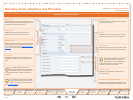
D 14049.01
07.2007
60
Text goes here
TANDBERG VIDEO COMMUNICATION SERVER
ADMINISTRATOR GUIDE
Introduction
Getting
Started
System
Overview
System
Configuration
H.323 & SIP
Configuration
Registration
Control
Zones and
Neighbors
Call
Processing
Firewall
Traversal
Bandwidth
Control
Maintenance
Appendices
TANDBERG VIDEO COMMUNICATION SERVER
ADMINISTRATOR GUIDE
Call
Processing
Call Processing
Process
The process followed by the VCS when attempting to locate a
destination endpoint is shown in the diagram opposite.
The user enters into their endpoint the an alias or address
of the destination endpoint. This can be in a number of
different formats.
The destination address is sent from the caller’s endpoint to
its local VCS (i.e. the VCS to which it is registered).
The VCS applies any Local Zone transforms to the alias.
The VCS applies any Administrator Policy to the
(transformed) alias. If this results in a new alias, the
process starts again, with the new alias checked against the
Local Zone transforms.
The VCS applies any User Policy to the alias. If the alias is a
FindMe name, the process will start again; all the resulting
aliases will be checked against Local Zone transforms and
Administrator Policy.
The VCS then checks all its local registrations and those
of its Alternates for the alias, placing the call if the alias is
found.
If the alias is not found locally, the VCS will then query its
zones, in priority order, to see if any of them can find the
alias. If the alias matches an ENUM zone, this may return
a URI. If so, the process starts again; the URI is checked
against any Local Zone transforms, Administrator Policy and
User Policy.
If the alias is found by one of the neighbor zones, the call
will be placed to that zone.
1.
2.
3.
4.
5.
6.
7.
8.
Locating a Destination Endpoint
Overview
One of the functions of the VCS is to route calls to their
appropriate destination, based on the address or alias received
by a locally registered endpoint or neighbor zone.
There are a number of steps involved in determining the
destination of a call, and some of these steps can involve
transforming the alias or redirecting the call to other aliases. It
is important to understand the process before setting up your
dial plan so you can avoid circular references.


















